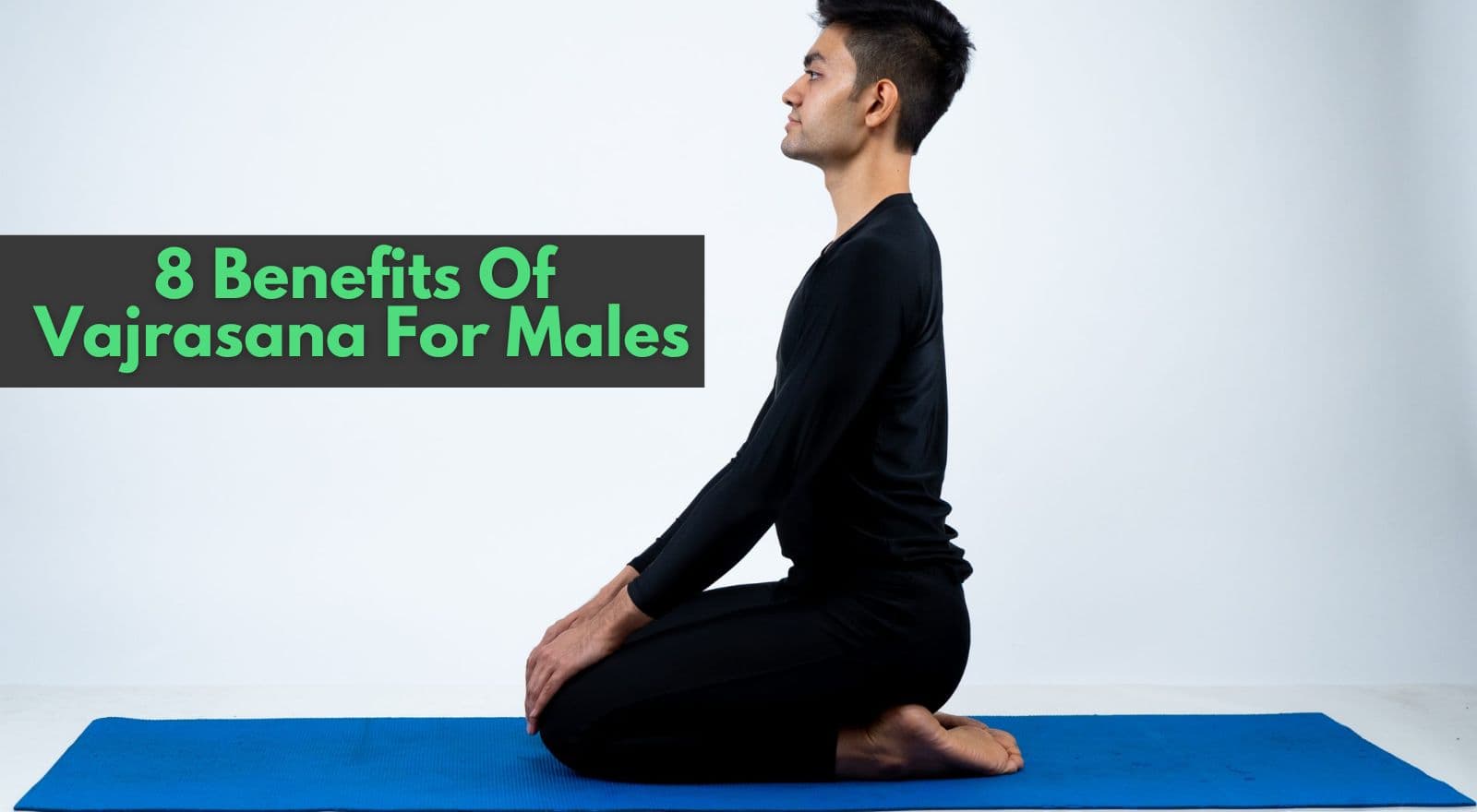Vajrasana is a relaxing yoga pose, and the name is derived from the Sanskrit word Vajra, which translates to thunderbolt or diamond, symbolising strength and indestructibility.
Vajrasana is a simple yet powerful pose that’s great for your posture and digestion. It’s more than just a relaxing stretch—it can help ease back pain, calm your mind, and give you a break from the chaos of daily life. For men, Vajrasana is especially helpful as it strengthens the pelvic muscles, boosts flexibility, and helps relieve stress.
In this blog, we’ll dive into the many health benefits of Vajrasana for men, whether you’re already practising it or thinking about giving it a try!
Table of Contents
- 8 Benefits of Sitting In Vajrasana For Men
- How To Do Vajrasana & Who Should Avoid It?
- Expert’s Advice
- The Final Say
- FAQs
- References
8 Benefits of Sitting In Vajrasana For Men
Here are some of the remarkable benefits of Vajrasana for men that would make you want to do it every day:
1. Good For The Digestive System
Vajrasana promotes proper posture and enhances blood flow to the abdominal area, which helps in better digestion. When you sit in Vajrasana, the pressure on your abdomen can stimulate your digestive organs, allowing them to work more efficiently.
Vajrasana also helps relieve bloating and constipation by improving the movement of food through the digestive tract.
Plus, it can reduce acid reflux and indigestion by keeping the stomach in a more natural position. Practising Vajrasana after meals can aid in digestion and help you feel lighter.
Also Read: Yoga For Digestive Health: Improve Gut Function And Relieve Discomfort
2. Relaxes The Mind
What yoga does best is soothe your mind, right? When you sit in this posture, it encourages a sense of calm and stillness, which can help reduce stress and anxiety. It includes focusing on breathing and grounding yourself, which allows your mind to shift away from distractions, bringing you into a state of mindfulness. It's an excellent way to calm your mind and improve mental clarity.
Also Read: Find Calm In Chaos — Mindfulness Meditation For Beginners: A How-To Guide
3. Relieves Back Pain
Back pain, especially at the lower end of the back, is a common problem for many. Sitting in Vajrasan strengthens your lower back muscles and helps align the spine to support better posture, reducing pressure on the lower back. This may be especially beneficial for those who sit for too long or have poor posture habits.
4. Improves Posture
When you sit in this pose, you must hold a straight spine, which helps counteract the effects of slouching or sitting for long hours. By doing this and engaging your core, this asana strengthens the muscles that support good posture. This can help reduce the strain on your neck and shoulders while promoting overall spinal health.
5. Reduces Hypertension
This yoga asana for high blood pressure encourages relaxation, which helps lower stress levels—a common contributor to elevated blood pressure. By promoting deep breathing and calming the mind, Vajrasana can trigger the body's parasympathetic nervous system, leading to a lowered heart rate and blood pressure. Regularly practising this asana can help in managing hypertension over time, especially when combined with other healthy lifestyle habits.
6. Eases Arthritis Pain
In Vajrasana or Diamond Posa, you need to sit on the heels of your feet, and this stretch can increase the flexibility of your thighs and improve blood circulation. This can reduce the stiffness and discomfort that come with conditions like arthritis.
7. Strengthens The Pelvic Floor Muscles
Sitting in Vajrasana can strengthen your pelvic floor muscles as it promotes better blood circulation in the lower body, including the pelvis. This targeted pelvic muscles exercise for men strengthens the pelvic floor muscles and benefits people who can experience urinary incontinence. Women are also advised to make this pose to alleviate pain caused by menstrual convulsions and work.
8. Reproductive Health
Vajrasana stimulates the reproductive organs by increasing blood flow to the area. This boosts the health of men's sexual organs, which may even provide greater sexual efficiency and improve reproductive health.
How To Do Vajrasana & Who Should Avoid It?
Vajrasana is a simple yoga pose that almost everyone can do. Here’s how to do it perfectly:
How To Do Vajrasana? |
| Step 1: Kneel on the floor. |
| Step 2: Lower your hips to rest them on your heels, with your thighs on calves. |
| Step 3: Sit upright with your spine aligned, shoulders relaxed, and chest open. |
| Step 4: Keep your back straight, look forward and fix it on a specific thing just in front of you. Also, hold your head straight and chin parallel to the ground. |
| Step 5: Rest your hands on your knees, with palms facing up or down. |
| Step 6: Pull your attention from the surroundings and concentrate on breathing. Slowly inhale and let your mind focus on your rhythmic breathing as you try to block other thoughts. |
| Step 7: Start by holding the pose for 5-10 minutes. Gradually increase the time as you become more comfortable. |
Vajrasana should be avoided by individuals who have:
- Knee or ankle issues
- Severe back pain
- Pregnancy
- Digestive conditions like acid reflux
- Recent surgery
Expert’s Advice
Incorporating vajrasana into your practice (or just doing it on its own) can significantly improve your overall well-being. If you’re new to Vajrasana, then I recommend starting by sitting for just a few minutes, perhaps 5-10 minutes, and gradually increasing the time as your body gets used to the position. Additionally, if sitting directly on your heels is uncomfortable, try using a cushion or a folded blanket under your hips to make the pose more comfortable.
Health Expert
Lavina Chauhan
The Final Say
Vajrasana pose, also known as the thunderbolt pose, is easy to do and brings a ton of health benefits, from better posture and digestion to the relaxation of the mind and reduced back pain. With regular practice, you can enhance physical health and promote mental clarity.
Remember to start slow and do it for shorter durations (around 5-10 minutes) if you’re a beginner, and then slowly increase the time to reap the benefits of Vajrasana and avoid the pose if you have certain health conditions.
FAQs
1. Can we do Vajrasana at night?
Yes, you can do Vajrasana at night. In fact, it is considered one of the best yoga poses to practice after dinner and can significantly improve sleep quality by supporting relaxation and digestion support, making it a beneficial supplement to the night routine.
2. Can Vajrasana cure gas problems?
Yes, Vajrasana can help alleviate the gas problems by improving the blood circulation in the abdominal area, which stimulates digestion and can help alleviate gas and flatulence. It is often recommended to exercise after a meal to help digest and reduce the accumulation of gas.
3. What is the ideal Vajrasana time?
The ideal time for Vajrasana is 10-20 minutes, but if you’re a beginner, do it for 5-10 minutes to get comfortable.
References
- https://www.rishikulyogshalarishikesh.com/blog/vajrasana-pose/amp/
- https://www.beatoapp.com/blog/benefits-of-vajrasana-yoga-aasana/
- https://www.pristyncare.com/blog/yoga-for-urethral-stricture-pc0441/#The_common_symptoms_of_the_urethral_stricture_include_the_following
- https://www.healthshots.com/intimate-health/sexual-health/erectile-dysfunction-yoga-asanas-to-help-your-partner/
- https://yogateachertrainingschool.com/blog/vajrasana-pose/
- https://timesofindia.indiatimes.com/life-style/health-fitness/wellness/yoga-for-insomnia-yoga-asanas-that-are-safe-to-do-at-night/photostory/102455860.cms?picid=102455949
About ToneOp Fit
ToneOp Fit is a platform dedicated to improving and maintaining good health through a comprehensive range of goal-oriented health plans with up to 3 Coach support. With a range of Weight Management, Medical Condition, Detox Plans, and Face Yoga Plans, the app also provides premium health trackers, recipes and health content. Get customised diet, fitness, naturopathy & yoga plans and transform yourself with ToneOp.










































